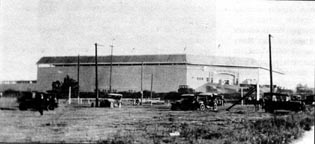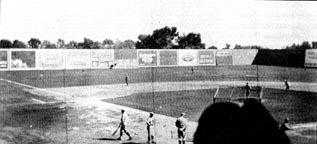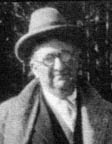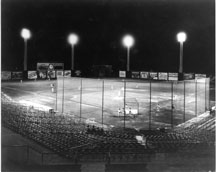 |  |
Moreing Field
 |  |
Lewis Moreing was a builder from Stockton, California who became interested in baseball when his younger brothers Cy and Will started playing in the outlaw California State League shortly after the formation of the Pacific Coast League in 1903. In 1918, Lew and his other brother Charlie became stockholders in the Sacramento Senators of the PCL.
After a record breaking attendance of 65,000 in 1919, outside interests had offered to by the club for up to $35,000, but the directors wanted to keep the team in Sacramento, so Lew and Charlie Moreing acquired the team in exchange for an agreement to assume its debts of $14,000.
 |
In his book Sacramento Senators and Solons, here is how PCL historian John E. Spalding describes the rebuilding of the ballpark:
"Sloping concrete formed the base for a huge 10,000-seat grandstand that was topped by a 30-foot high outer wall supporting a roof which shaded the seats from the hot sun that baked the Sacramento Valley every summer. A space was left between the top of the wall and the roof to allow breezes to blow across the seats. Fans reached the grandstand entrance by walking up a large ramp from the corner of Riverside Boulevard and Y Street (now Broadway). The spacious grandstand's center reserved section featured 1,400 "comfort seats" - benches with wooden backs and arms. The seating areas were served by wide aisles for easy access.
"More than a month before the season opener, club secretary Charlie Doyle told the Sacramento Union that demand for box seat tickets was so great that owner Lew Moreing had ordered carpenters to double the number of boxes.
"Concrete pads stretched down the first and third base lines to support wooden bleacher seating. Even farther down the lines were smaller wooden bleacher sections, all under cover.
"The new ballpark had seats for 10,000 fans compared to the 6,000-seat capacity of its predecessor.
"The main structure was much larger than Buffalo Park so the diamond was relocated and the fences changed. Left field was shortened from 350 to 320 feet because no one had ever cleared the barrier. Land was purchased to make it possible to lengthen the right field distance from 280 to 330. The outfield was surrounded by a 20-foot high wooden fence, eight feet higher than the old one.
"Moreing Field was no home run park. Only 20 home runs left the premises in 1922 and 15 were hit by visitors. Only three balls were hit over the right field fence.
"A woman's rest room, 'similar to a department store's,' was included for the first time in a PCL park, the Sacramento Bee reported. There was a new and larger concession stand where fans could buy food and cold drinks. Parking for hundreds of automobiles was available beyond the left field fence.
"Moreing provided new quarters for players and umpires. The players' locker rooms were located beneath the grandstand. Each contained 24 lockers, showers and modern heating.
"Moreing invested an estimated $100,000 in his baseball palace."
Moreing Field opened on April 4, 1922, when a crowd estimated at 13,500 by the San Francisco Chronicle jammed into the new ballpark. (The Sacramento Bee said the paid attendance was 10,362.) Governor William Stephens threw out the first pitch to City Manager Clyde Seavey, and Lew and Charlie Moreing were given flower arrangements.
 Eight years later, baseball history was made at Moreing Field, when it became the site of the first night baseball game on the West Coast. Here is how Spalding recounts it:
Eight years later, baseball history was made at Moreing Field, when it became the site of the first night baseball game on the West Coast. Here is how Spalding recounts it:
"Baseball under the lights had been tried with limited success on a few occasions dating back to the 1880s, but professional teams shunned the idea until 1930. Early in the year, E. Lee Keyser, president of the Des Moines Demons in the Class A Western League, announced he would install permanent lights and schedule the first night game on May 2. Although another game was held under temporary lights five days earlier in the Class C Western Association, Keyser's night game drew nationwide attention. Commissioner Landis was in the stands with 12,000 others on game night as a national audience heard NEC's radio broadcast of Des Moines' 13-6 win over Wichita.
"Moreing said he had been considering erecting lights at his ballpark for two years since working people couldn't attend afternoon weekday games. 'Sacramento would be an ideal city for night baseball as the climate is just right during the summer evenings,' he said. Moreing put in an order for poles and lights and three weeks later announced the Senators would play the Oakland Oaks on June 10 in the Coast League's first nocturnal contest.
"While the team was out of town on June 5, Moreing tested the lights in a game matching former Senators and rookies who were not taken on the road trip. Hundreds of automobiles lined streets around Moreing Field for an hour before the banks of 40 lights atop four tall wooden poles were turned on by Moreing at 8:31 p.m., showering the field with 180,000 watts of light. 'Every corner of the diamond was lighted like day,' said the Sacramento Bee.
"'The first ball pitched . . . met the hitter's bat for a long drive into center field,' reported Sacramento Union sports editor Steve George. 'The ball was visible from the time it left the pitcher's hand until it fell smack against the centerfielder's glove. "'Lew Moreing's $10,000 gamble was a success. Old Sol was never more neatly eclipsed by the moon than he is by the new lights at Moreing Field.'
"In the dress rehearsal game, rookies Steinbacher and Clem Coyle hit home runs. No one blasted the ball over the fence on June 10, but the 10,000 Sacramento fans who passed through the turnstiles saw Bryan pitch a five-hit, 8- 0, victory over the Oaks. Reserved seats that normally sold for $1.50 were going for $10 before the game, but the crowd was several thousand under the ballpark's record because many fans stayed away, fearful they would not be able to get in to see the historic game.
"While a Pacific Coast radio audience listened to sportscaster Ernie Smith's description of the game, 30 sportswriters, PCL president Harry Williams and officials from Coast League teams watched the action from the stands. Convinced of the potential to increase attendance, other PCL teams jumped on the night game bandwagon."
By the end of the season four of the League's seven other teams had added lights, and San Francisco's two teams followed suit the next year when Seals Stadium opened. The last to hold out, Bill Lane of San Diego, changed his mind after Sacramento's attendance soared to 219,300, surpassing even the American League's St. Louis Browns by more than 67,000.
Lew Moreing died in 1935. It was in that same year that the Sacramento Senators became a farm team for the St Louis Cardinals owned by Branch Rickey. Following a poll by the Sacramento Union, the park was renamed "Cardinal Field."
| HOME |
Copyright © 2003. William B.Shubb.